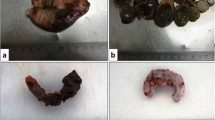Abstract
Background
The purpose of this study was to assess the need for a routine histopathologic examination of three common surgical specimens (appendix, gallbladder, hemorrhoid) and its impact on the further management of the patients.
Methods
Histopathologic reports of patients undergoing appendectomy, cholecystectomy, or hemorrhoidectomy performed between 1998 and 2006 in the Faculty of Medicine, Siriraj Hospital were reviewed. The reports were excluded if patients had a clinical diagnosis or suspicion of malignancy. The incidence of unexpected pathologic diagnoses and their impact on postoperative management were evaluated.
Results
Of 4545 appendectomy specimens, 44 (0.97%) revealed incidental unexpected pathological diagnoses, including one adenocarcinoma and one primary appendiceal lymphoma. About one-fifth of such unexpected appendiceal findings had an impact on postoperative treatment. Unexpected pathologic gallbladder findings were found in 88 (2%) of 4317 cholecystectomy specimens. Gallbladder cancer (GBC) was detected in 24 specimens (0.56%). A clinical diagnosis of empyema and patient’s age over 60 years were two significant risk factors for an unexpected GBC [odds ratio (OR) 11.0, 95% confidence interval (CI) 4.2–29.2 and OR 6.2, 95% CI 2.1–18.2, respectively]. About one-fourth of patients with unexpected gallbladder findings required further management. Of 914 hemorrhoidectomy specimens, there were 13 (1.4%) histologic abnormalities other than the usually expected lesions in hemorrhoids. None of these altered postoperative management.
Conclusions
The routine histopathology examination of the appendix and gallbladder, particularly in cases of empyema and patient’s age over 60 years, is of value for identifying unsuspected conditions requiring further postoperative management. However, routine histopathologic evaluation of the hemorrhoid seems unnecessary.
Similar content being viewed by others

References
Strobel SL (2006) Enhancing the pathologist’s role at hospital tumor boards. Ann Clin Lab Sci 36:243–247
Murata T (2006) Pathology service and practice: solo-practice pathologist in a community hospital in Japan—personal experience and a proposal for cost- and time-effective practice. Pathol Int 56:480–483
Matthyssens LE, Ziol M, Barrat C et al (2006) Routine surgical pathology in general surgery. Br J Surg 93:362–368
Miller GG, McDonald SE, Milbrandt K et al (2003) Routine pathological evaluation of tissue from inguinal hernias in children is unnecessary. Can J Surg 46:117–119
McKeon K, Boyer MI, Goldfarb CA (2006) Use of routine histologic evaluation of carpal ganglions. J Hand Surg [Am] 31:284–288
Erdag TK, Ecevit MC, Guneri EA et al (2005) Pathologic evaluation of routine tonsillectomy and adenoidectomy specimens in the pediatric population: is it really necessary? Int J Pediatr Otorhinolaryngol 69:1321–1325
Fitzgibbons P, Cleary K (1996) CAP offers recommendations on selecting surgical specimens for examination. CAP Today 10:40
Cross SS, Stone JL (2002) Proactive management of histopathology workloads: analysis of the UK Royal College of Pathologists’ recommendations on specimens of limited or no clinical value on the workload of a teaching hospital gastrointestinal pathology service. J Clin Pathol 55:850–852
Jones AE, Phillips AW, Jarvis JR et al (2007) The value of routine histopathological examination of appendicectomy specimens. BMC Surg 7:17
Lemarchand N, Tanne F, Aubert M et al (2004) Is routine pathologic evaluation of hemorrhoidectomy specimens necessary? Gastroenterol Clin Biol 28:659–661
Bazoua G, Hamza N, Lazim T (2007) Do we need histology for a normal-looking gallbladder? J Hepatobiliary Pancreat Surg 14:564–568
Cataldo PA, MacKeigan JM (1992) The necessity of routine pathologic evaluation of hemorrhoidectomy specimens. Surg Gynecol Obstet 174:302–304
Darmas B, Mahmud S, Abbas A et al (2007) Is there any justification for the routine histological examination of straightforward cholecystectomy specimens? Ann R Coll Surg Engl 89:238–241
Khan OA, Morhan A, Jegatheeswaran S et al (2007) Routine pathological analysis of appendicectomy specimens: is it justified? Acta Chir Belg 107:529–530
Lai CH, Lau WY (2008) Gallbladder cancer: a comprehensive review. Surgeon 6:101–110
Wood R, Fraser LA, Brewster DH et al (2003) Epidemiology of gallbladder cancer and trends in cholecystectomy rates in Scotland, 1968–1998. Eur J Cancer 39:2080–2086
Kwon AH, Imamura A, Kitade H et al (2008) Unsuspected gallbladder cancer diagnosed during or after laparoscopic cholecystectomy. J Surg Oncol 97:241–245
Roa I, Araya JC, Villaseca M et al (1999) Gallbladder cancer in a high risk area: morphological features and spread patterns. Hepatogastroenterology 46:1540–1546
Timaran CH, Sangwan YP, Solla JA (2000) Adenocarcinoma in a hemorrhoidectomy specimen: case report and review of the literature. Am Surg 66:789–792
Bauer P, De Parades V, Etienney I et al (2005) About “Is routine pathologic evaluation of hemorrhoidectomy specimens necessary?”. Gastroenterol Clin Biol 29:213–214
Author information
Authors and Affiliations
Corresponding author
Rights and permissions
About this article
Cite this article
Lohsiriwat, V., Vongjirad, A. & Lohsiriwat, D. Value of Routine Histopathologic Examination of Three Common Surgical Specimens: Appendix, Gallbladder, and Hemorrhoid. World J Surg 33, 2189–2193 (2009). https://doi.org/10.1007/s00268-009-0164-6
Published:
Issue Date:
DOI: https://doi.org/10.1007/s00268-009-0164-6



